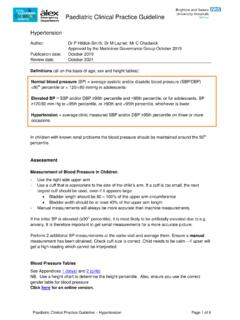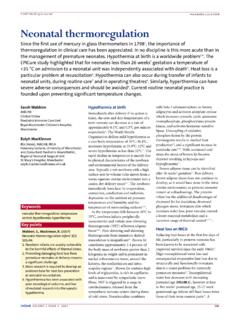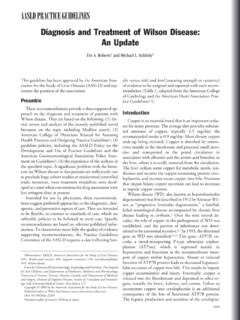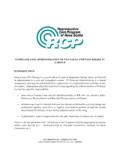Transcription of Guideline: Normal birth - Queensland Health
1 Maternity and NeonatalClinical GuidelineQueensland Health clinical Excellence Queensland Normal birth Queensland clinical Guideline: Normal birth Refer to online version, destroy printed copies after use Page 2 of 38 Document title: Normal birth Publication date: December 2022 Document number: Document supplement: The document supplement details development processes and implementation activities, and is integral to and should be read in conjunction with this guideline Amendments: Full version history is supplied in the document supplement Amendment date: June 2018 Replaces document: Author: Queensland clinical guidelines Audience: Health professionals in Queensland public and private maternity and neonatal services Review date: December 2027 Endorsed by: Queensland clinical guidelines Steering Committee Statewide Maternity and neonatal clinical Network ( Queensland ) Contact: Email: URL: Disclaimer This guideline is intended as a guide and provided for information purposes only.
2 The information has been prepared using a multidisciplinary approach with reference to the best information and evidence available at the time of preparation. No assurance is given that the information is entirely complete, current, or accurate in every respect. The guideline is not a substitute for clinical judgement, knowledge and expertise, or medical advice. Variation from the guideline, taking into account individual circumstances, may be appropriate. This guideline does not address all elements of standard practice and accepts that individual clinicians are responsible for: Providing care within the context of locally available resources, expertise, and scope of practice Supporting consumer rights and informed decision making, including the right to decline intervention or ongoing management Advising consumers of their choices in an environment that is culturally appropriate and which enables comfortable and confidential discussion.
3 This includes the use of interpreter services where necessary Ensuring informed consent is obtained prior to delivering care Meeting all legislative requirements and professional standards Applying standard precautions, and additional precautions as necessary, when delivering care Documenting all care in accordance with mandatory and local requirements Queensland Health disclaims, to the maximum extent permitted by law, all responsibility and all liability (including without limitation, liability in negligence) for all expenses, losses, damages and costs incurred for any reason associated with the use of this guideline, including the materials within or referred to throughout this document being in any way inaccurate, out of context, incomplete or unavailable. Recommended citation: Queensland clinical guidelines .
4 Normal birth Guideline No. Queensland Health . 2022. Available from: State of Queensland ( Queensland Health ) 2022 This work is licensed under a Creative Commons Attribution-NonCommercial-NoDerivatives International licence. In essence, you are free to copy and communicate the work in its current form for non-commercial purposes, as long as you attribute Queensland clinical guidelines , Queensland Health and abide by the licence terms. You may not alter or adapt the work in any way. To view a copy of this licence, visit For further information, contact Queensland clinical guidelines , RBWH Post Office, Herston Qld 4029, email For permissions beyond the scope of this licence, contact: Intellectual Property Officer, Queensland Health , GPO Box 48, Brisbane Qld 4001, email Cultural acknowledgement The Department of Health acknowledges the Traditional Custodians of the lands, waters and seas across the State of Queensland on which we work and live.
5 We also acknowledge First Nations peoples in Queensland are both Aboriginal Peoples and Torres Strait Islander Peoples and pay respect to the Aboriginal and Torres Strait Islander Elders past, present and emerging. Queensland clinical Guideline: Normal birth Refer to online version, destroy printed copies after use Page 3 of 38 Flow Chart: Normal birth initial assessment Queensland clinical guidelines : Normal birth . Flowchart version: Initial contact Reason for presentation/contact Preferences for labour and birth Emotional and psychological needsReview history Verbal Pregnancy Health Record/antenatal records Obstetric, gynaecological, medical, surgical, social, family history Investigations and results Medications and allergies Pregnancy complications Psychosocial, cultural and spiritualContractions Time commenced Duration, strength, frequency and resting tone Maternal observations Temperature, pulse, respiratory rate, BP Urinalysis Nutritional and hydration status General appearanceAbdominal assessment Observation and palpation Fundal height, lie, presentation, attitude, position, engagement/descent.
6 Liquor volumeFetal wellbeing Ask about fetal movements Auscultate FHR towards the end of contraction and continue for at least 30 60 seconds after contraction finished Differentiate fetal heart beat from maternal pulseVaginal loss Nil, discharge, liquor, blood Note colour, odour, amount, and consistencyVaginal examination If stage of labour uncertain, may assist decision making If SROM consider speculum examinationDiscomfort and pain Reassure, promote, reinforce coping strategies Assess response to contractions Review birth plan and note preferences Discuss advantages/disadvantages of optionsRepeat contacts Review entire contact history and clinical circumstances with each contact Refer/consult/request woman to present for assessment as requiredDiscuss, consult, refer, manage as per professional# and Queensland guidelinesRisk factors?
7 Not yet in labourAntenatal assessmentTriage stage of labourSecond stage Refer to flow chart: Normal birth Second stageFirst stageRefer to flow chart: Normal birth First stage YesNoPregnant woman with signs of labour at termCare is woman centred and includes informed choice, consent, privacy and respectful communication. Contemporaneous documentation is essential. BP: blood pressure, FHR: fetal heart rate, VE: vaginal examination, SROM: spontaneous rupture of membranes, #Australian College of Midwives: National Midwifery guidelines for Consultation and Referral. 4th Edition, Issue 3. 2021 Queensland clinical Guideline: Normal birth Refer to online version, destroy printed copies after use Page 4 of 38 Flow Chart: Normal birth first stage Queensland clinical guidelines : Normal birth .
8 Flowchart version: Active first stageSupportive care Consider measures to promote, protect and support Normal birth including:o One-to-one midwifery supporto Review birth plano Environment (privacy, calmness, lighting)o Mobilisation and positioningo Involve support people/partnero Cultural supports, if requiredo Comfort and pain management strategiesOngoing (following initial) assessment Maternal and fetal condition Progress and descent of the fetal head FHR: every 15 30 minutes intermittent auscultation o Differentiate from maternal pulse Temperature and BP: 4 hourly Maternal pulse: every 30 minutes Abdominal palpation: 4 hourly, prior to VE and as required to monitor progress Contractions: every 30 minutes for 10 minutes Vaginal loss: hourly Offer VE: 4 hourly and if indicated Nutrition as desired and encourage hydration Bladder: monitor/encourage 2 hourly voiding Emotional coping, discomfort and painFirst stagein the low risk woman at term Discuss, consult, refer, manage as per professional# and Queensland guidelinesSecond stage Refer to flow chart: Normal birth Second stageRegular painful contractionsAND some cervical effacement AND dilatation of at least4 6 cm?
9 Risk factors ordiagnosis of delay? Delay in active first stage Protracted labour cervical dilatation of:o Nulliparous: < 2 cm in 4 hourso Multiparous: < 2 cm in 4 hours or a slowing of progress Arrest in labour: Diagnosed at cervical dilatation of 6 cm with ruptured membranes and no or limited cervical change for four hours of adequate contractionsYesNoYesNoLatent first stageIrregular painful contractions and some cervical effacement and dilatation less than 4 6 cm Complete an initial assessment Reassure latent phase is Normal Offer individualised support about rest, hydration, nutrition Advise mobilisation may establish contractions Discuss comfort strategies and their risks and benefits Involve support people/partner Offer admission or return/remain at home according to individual need/circumstances Provide information on when to return to hospital and/or notify healthcare professionaloIncreasing strength, frequency.
10 Duration of contractionsoRequiring pain managementoVaginal bleeding, rupture of membranesoReduced fetal movementoAny concerns Plan an agreed time for reassessment Continue care as per active first stage Anticipate vaginal birth Identify commencement of second stageCare is woman centred and includes informed choice, consent, privacy and respectful communication. Contemporaneous documentation is essential. BP: blood pressure, FHR: fetal heart rate, VE: vaginal examination, >: greater than, : greater than or equal to, <: less than #Australian College of Midwives: National Midwifery guidelines for Consultation and Referral. 4th Edition, Issue 3. 2021 Queensland clinical Guideline: Normal birth Refer to online version, destroy printed copies after use Page 5 of 38 Flow Chart: Normal birth second stage Queensland clinical guidelines : Normal birth .













